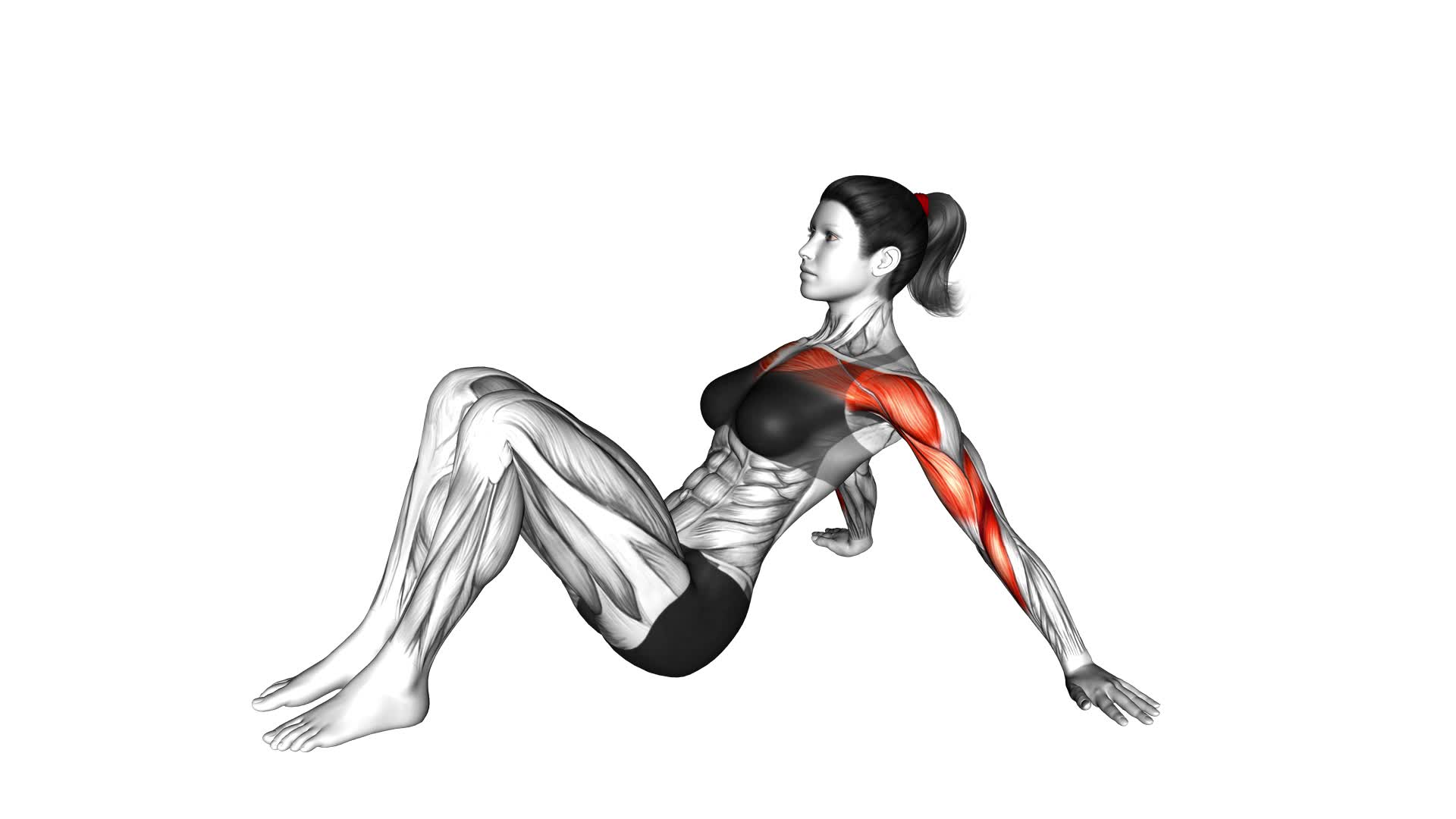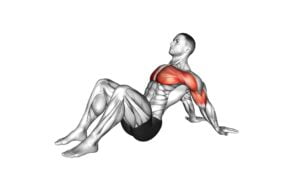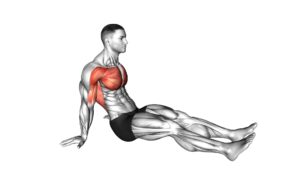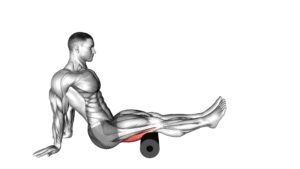Seated Shoulder Flexor Depressor Retractor Stretch Bent Knee (female) – Video Exercise Guide & Tips

Are you looking for an effective stretch to improve your shoulder flexibility and strength? Look no further than the Seated Shoulder Flexor Depressor Retractor Stretch.
Watch This Exercise Video
This video exercise guide will walk you through the proper form and body alignment, modifications for all fitness levels, and common mistakes to avoid.
Plus, we'll share tips to maximize the stretch and show you how to incorporate this stretch into your fitness routine.
Get ready to feel the benefits and take your shoulder mobility to the next level.
Key Takeaways
- Improved flexibility and range of motion in the shoulders
- Targets flexor, depressor, and retractor muscles essential for posture and everyday activities
- Relieves tension and tightness in the shoulder muscles
- Promotes overall shoulder health and function
Benefits of the Seated Shoulder Flexor Depressor Retractor Stretch
You will experience improved flexibility and range of motion in your shoulders with the Seated Shoulder Flexor Depressor Retractor Stretch. This exercise specifically targets the shoulder muscles, helping to increase their flexibility and activate them for better performance. By incorporating this stretch into your routine, you can enhance the overall mobility and functionality of your shoulder joints.
The Seated Shoulder Flexor Depressor Retractor Stretch focuses on stretching and activating the muscles responsible for shoulder movement. As you perform this stretch, you'll feel a gentle pull in your shoulder muscles, indicating that they're being stretched and engaged. This stretch targets the flexor, depressor, and retractor muscles of the shoulders, which are essential for maintaining proper posture and performing everyday activities.
By regularly performing the Seated Shoulder Flexor Depressor Retractor Stretch, you can improve your shoulder flexibility, allowing for a wider range of motion. This increased flexibility can be beneficial for various activities, such as reaching overhead, lifting objects, and participating in sports that require shoulder mobility. Additionally, activating these muscles can help prevent injuries and improve overall shoulder stability.
Proper Form and Body Alignment
To ensure you're performing the Seated Shoulder Flexor Depresor Retractor Stretch with proper form and body alignment, it's essential to maintain correct posture throughout the exercise.
This will help prevent injuries and maximize the effectiveness of the stretch. Pay attention to your body's alignment, keeping your back straight, shoulders relaxed, and neck in a neutral position.
Maintaining Correct Posture
Maintain correct posture by ensuring proper form and body alignment during the Seated Shoulder Flexor Depresor Retractor Stretch Bent Knee exercise.
Maintaining correct posture is essential for maximizing the benefits of this stretch and preventing injury. To achieve proper form, sit up straight with your shoulders pulled back and down. Keep your chest lifted and your spine aligned.
Engage your core muscles to support your posture and avoid slouching. Incorporating correct posture into your daily routine can help improve your overall posture and prevent muscle imbalances.
By practicing good posture during this exercise, you're training your body to maintain proper alignment, which can reduce the risk of strain or injury.
Now, let's explore how correct alignment can further contribute to injury prevention.
Alignment for Injury Prevention
Achieve optimal injury prevention by ensuring proper form and body alignment during the Seated Shoulder Flexor Depresor Retractor Stretch Bent Knee exercise.
To reduce the risk of injury and maximize the effectiveness of this stretch, it's important to follow correct alignment techniques. Start by sitting up tall with your back straight and shoulders relaxed. Keep your chin parallel to the floor and avoid slouching or rounding your back.
Engage your core muscles to stabilize your spine and maintain a neutral pelvis. As you perform the stretch, focus on keeping your shoulder blades down and back, and avoid shrugging your shoulders. By practicing these injury prevention techniques and maintaining proper alignment, you can minimize the risk of strain or injury.
Now, let's move on to modifications for beginners and advanced levels.
Modifications for Beginners and Advanced Levels
For beginners and advanced individuals, try modifying the Seated Shoulder Flexor Depresor Retractor Stretch Bent Knee exercise to suit your fitness level.
If you're a beginner, start by sitting on a chair with your feet flat on the ground and your knees bent at a 90-degree angle. Place your hands on the armrests or on your thighs for support. Slowly lean forward, keeping your back straight, until you feel a gentle stretch in your shoulders and upper back. Hold this position for 15-30 seconds, breathing deeply and relaxing into the stretch.
As you become more advanced, you can increase the intensity of the stretch by using a stability ball instead of a chair. Sit on the ball with your feet flat on the ground and your knees bent at a 90-degree angle. Place your hands on the ball in front of you and slowly roll the ball forward, allowing your upper body to stretch further.
Remember to listen to your body and only go as far as feels comfortable. With regular practice, the Seated Shoulder Flexor Depresor Retractor Stretch Bent Knee exercise can help improve your shoulder and upper back flexibility.
Common Mistakes to Avoid
To avoid common mistakes during the Seated Shoulder Flexor Depresor Retractor Stretch Bent Knee exercise, make sure to maintain proper form and alignment. Here are some modifications for beginners and common mistakes to avoid:
- Rounded Shoulders: Avoid rounding your shoulders forward during the stretch. Keep them pulled back and down to maintain proper alignment.
- Lifting Hips: Make sure to keep your hips firmly planted on the seat throughout the exercise. Lifting your hips can reduce the effectiveness of the stretch.
- Arching Back: Avoid arching your lower back excessively. Engage your core muscles to maintain a neutral spine position.
- Straining Neck: Be mindful of your neck position. Avoid straining or jutting your chin forward. Keep your neck relaxed and aligned with your spine.
- Overstretching: Don't push yourself too hard. Start with gentle stretches and gradually increase intensity over time to avoid injury.
By avoiding these common mistakes and focusing on proper form, you can maximize the benefits of the Seated Shoulder Flexor Depresor Retractor Stretch Bent Knee exercise.
Now, let's move on to the next section for tips on how to maximize the stretch and get the most out of this exercise.
Tips for Maximizing the Stretch
To further enhance the effectiveness of the Seated Shoulder Flexor Depressor Retractor Stretch Bent Knee exercise, it's essential to implement the following tips for maximizing the stretch. By following these tips, you can maximize flexibility and improve your range of motion.
First, make sure to warm up properly before attempting the stretch. This will help prepare your muscles for the exercise and prevent any potential injuries. A few minutes of light cardio, such as jogging or jumping jacks, can get your blood flowing and loosen up your muscles.
Next, focus on your breathing. Take slow, deep breaths throughout the stretch to help relax your muscles and increase the stretch. Exhale as you deepen the stretch and inhale as you release.
Additionally, try to hold the stretch for at least 30 seconds. This allows enough time for your muscles to relax and elongate. If you can, gradually increase the duration to 60 seconds.
Lastly, listen to your body. If you feel any sharp or intense pain, ease off the stretch immediately. It's important to push yourself, but not to the point of injuring yourself.
By incorporating these tips into your stretching routine, you can maximize flexibility and improve your range of motion.
Now, let's move on to the next section and discuss how to incorporate the seated shoulder flexor depressor retractor stretch into your fitness routine.
Incorporating the Seated Shoulder Flexor Depressor Retractor Stretch Into Your Fitness Routine
To incorporate the Seated Shoulder Flexor Depressor Retractor Stretch into your fitness routine, you should consider the benefits it offers for shoulder health.
This stretch helps to improve flexibility and mobility in the shoulders, reducing the risk of injuries and promoting overall shoulder strength.
Additionally, adding this stretch to your routine can also add variety and challenge to your workouts, keeping you engaged and motivated.
Stretching for Shoulder Health
You can incorporate the Seated Shoulder Flexor Depressor Retractor Stretch into your fitness routine to improve shoulder health. This stretch is effective for enhancing shoulder flexibility and mobility, allowing you to move more freely and comfortably. Here are five reasons why you should consider adding this stretch to your routine:
- Relieves tension and tightness in the shoulder muscles
- Improves range of motion in the shoulder joint
- Enhances posture by strengthening the muscles that support the shoulders
- Reduces the risk of shoulder injuries during physical activities
- Promotes overall shoulder health and function
Benefits of Shoulder Stretches
Incorporate the Seated Shoulder Flexor Depressor Retractor Stretch into your fitness routine for maximum shoulder health benefits.
Shoulder stretches, like this one, can greatly improve shoulder flexibility and mobility. By regularly performing this stretch, you can increase the range of motion in your shoulders, allowing for better performance in various activities and reducing the risk of injuries.
The Seated Shoulder Flexor Depressor Retractor Stretch targets the muscles responsible for shoulder flexion, depression, and retraction, helping to alleviate tension and tightness in these areas. This stretch is particularly beneficial for individuals who engage in activities that require overhead arm movements, such as weightlifting or swimming.
By incorporating shoulder stretches into your fitness routine, you can ensure that your shoulders stay mobile and flexible, promoting overall shoulder health and preventing discomfort or limitations.
Now, let's explore how you can add variety to your workouts to further enhance your fitness journey.
Adding Variety to Workouts
Start by incorporating the Seated Shoulder Flexor Depressor Retractor Stretch into your fitness routine to add variety and enhance your shoulder health. This exercise targets the muscles in your shoulders, helping to improve flexibility and reduce tension.
But why stop there? Here are five other workout variety options to keep your fitness routine fresh and exciting:
- Try interval training: Incorporating bursts of high-intensity exercises into your workouts can increase calorie burn and challenge your cardiovascular system.
- Explore different workout classes: Joining a yoga, Pilates, or dance class can introduce new movements and help you discover exercises you may not have tried before.
- Incorporate strength training: Adding resistance exercises to your routine can build muscle, boost metabolism, and enhance overall strength.
- Take your workout outdoors: Switch up your usual indoor routine by going for a run, bike ride, or hike in nature.
- Experiment with different equipment: Incorporate tools like resistance bands, stability balls, or kettlebells to engage your muscles in new ways.
Frequently Asked Questions
How Often Should I Do the Seated Shoulder Flexor Depressor Retractor Stretch?
You should do the seated shoulder flexor depressor retractor stretch regularly to reap its benefits.
By incorporating this stretch into your routine, you can improve the flexibility and strength of your shoulder muscles.
The frequency of this stretch will depend on your fitness level and goals, but aim for at least 2-3 times per week.
Consistency is key to maximize the benefits and prevent muscle tightness or imbalances.
Can I Perform This Stretch if I Have a Shoulder Injury?
If you have a shoulder injury, it's important to prioritize your shoulder's rehabilitation and avoid any exercises that may aggravate the injury further.
While the Seated Shoulder Flexor Depresor Retractor Stretch Bent Knee (female) may not be suitable for you at this time, there are alternative stretches specifically designed for shoulder injury rehabilitation that you can explore.
Consult with a healthcare professional or physical therapist to determine the best course of action for your specific injury.
Will This Stretch Help Improve My Posture?
Regular stretching can have benefits for improving posture. By incorporating stretches like the Seated Shoulder Flexor Depresor Retractor, you can target specific muscles that contribute to better posture. This stretch helps to lengthen and strengthen the muscles in your shoulders, promoting proper alignment.
However, it's important to note that improving posture requires a comprehensive approach. In addition to this stretch, incorporating other exercises and stretches that target different muscle groups can further enhance your posture.
Should I Feel Any Discomfort or Pain During the Stretch?
During the stretch, it's important to listen to your body. You shouldn't feel any discomfort or pain. If you do, it might be a sign that you need to modify the shoulder stretches or adjust your positioning.
Remember to take it slow and don't push yourself too hard. It's always best to consult with a professional or a trainer to ensure you're doing the stretch correctly and safely.
Can I Use Props or Equipment to Enhance the Stretch?
Yes, you can definitely use props or equipment to enhance the stretch.
There are several variations of the seated shoulder flexor depressor retractor stretch that can be done with the help of props or equipment.
For example, you can use a resistance band or a yoga strap to increase the intensity of the stretch.
These props can help you deepen the stretch and target specific muscles more effectively.
It's important to choose the appropriate props or equipment that suit your fitness level and goals.
Conclusion
Incorporating the seated shoulder flexor depressor retractor stretch into your fitness routine can provide numerous benefits, including improved shoulder flexibility and posture.
By following proper form and body alignment, avoiding common mistakes, and maximizing the stretch, you can effectively target and strengthen the muscles in your shoulders.
Whether you're a beginner or advanced, this stretch can be modified to suit your fitness level.
Add this exercise to your routine for a well-rounded upper body workout.

Author
Years ago, the spark of my life’s passion ignited in my mind the moment I stepped into the local gym for the first time. The inaugural bead of perspiration, the initial endeavor, the very first surge of endorphins, and a sense of pride that washed over me post-workout marked the beginning of my deep-seated interest in strength sports, fitness, and sports nutrition. This very curiosity blossomed rapidly into a profound fascination, propelling me to earn a Master’s degree in Physical Education from the Academy of Physical Education in Krakow, followed by a Sports Manager diploma from the Jagiellonian University. My journey of growth led me to gain more specialized qualifications, such as being a certified personal trainer with a focus on sports dietetics, a lifeguard, and an instructor for wellness and corrective gymnastics. Theoretical knowledge paired seamlessly with practical experience, reinforcing my belief that the transformation of individuals under my guidance was also a reflection of my personal growth. This belief holds true even today. Each day, I strive to push the boundaries and explore new realms. These realms gently elevate me to greater heights. The unique combination of passion for my field and the continuous quest for growth fuels my drive to break new ground.







